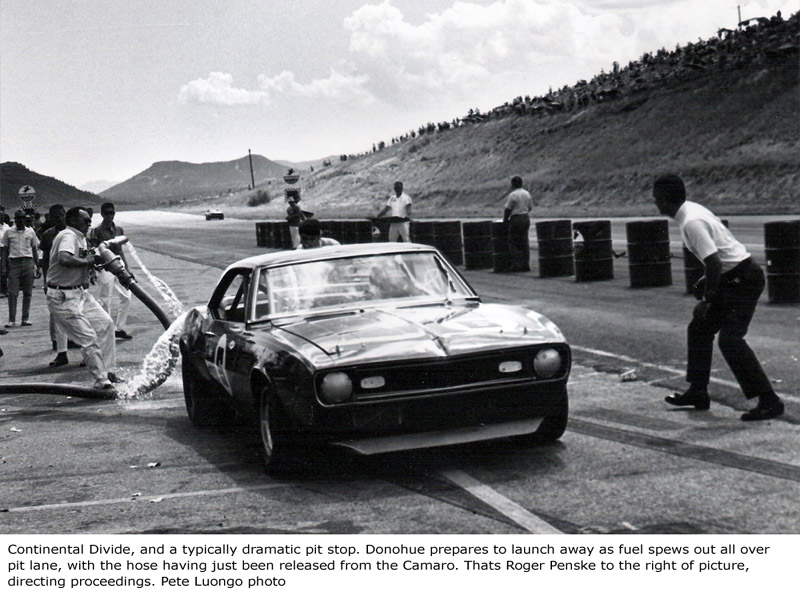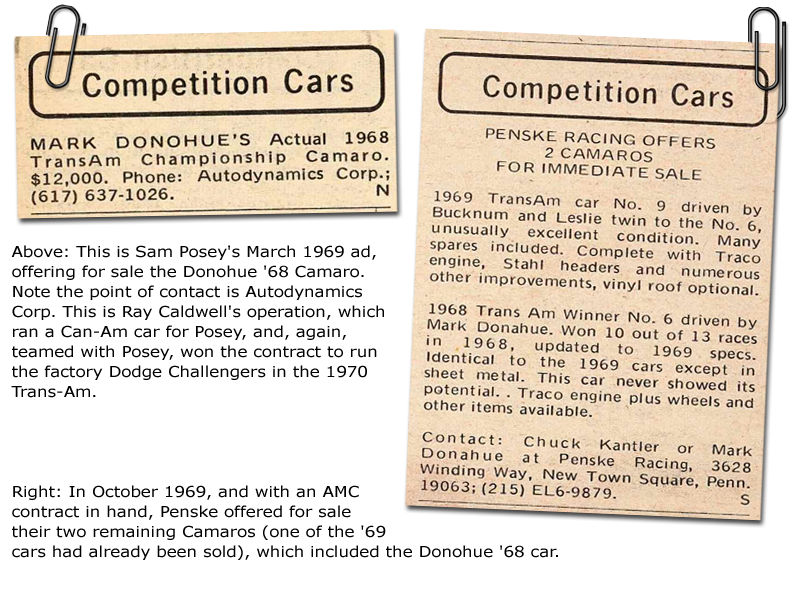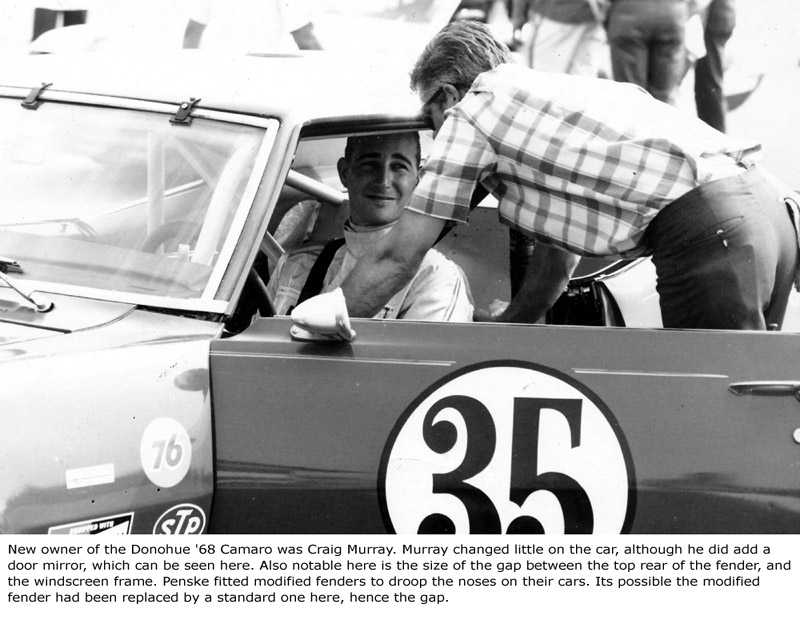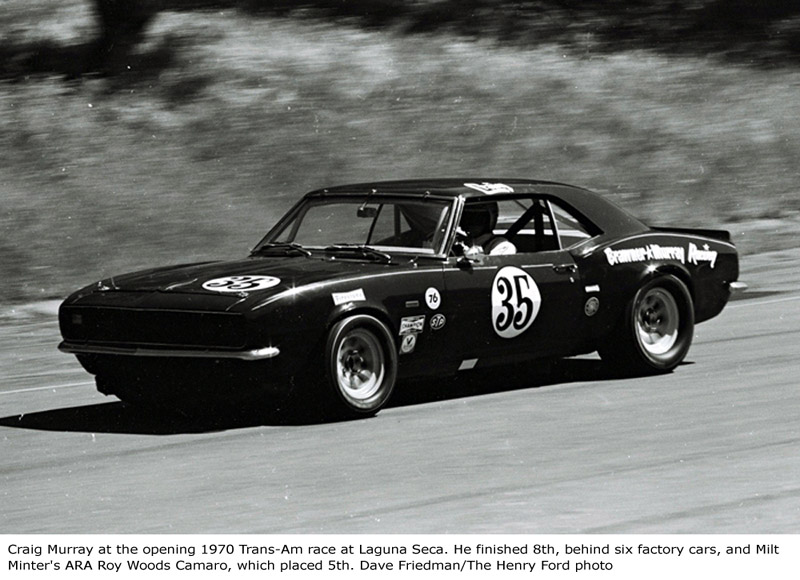-
Administrator


Given their trouncing at the hands of the Shelby team during pit stops at Daytona, Chevrolet’s Bill Howell devised an ingenious system for speeding up brake pad changes. Donohue explains: “The problem (when performing a normal pad change) was that when we slipped the old pads out, the pistons slid out, preventing the new pads from going in easily. The Ford guys had developed some special tools that pushed the pistons back into the calliper, but that took some time also. Bill’s idea was to put a vacuum on the master cylinder to pull the pistons back in. We already had a source, in the brake booster vacuum, so all we needed was a pressure regulator to prevent sucking air in past the pistons, and a valve so that the driver could actuate the system. When we got to Sebring and Roger saw the system, we had to show him that it worked. We jacked the car up in the garage with the engine running to create a vacuum. By the time the wheels were off the pistons had retracted, and the mechanics whipped the old pads out and the new ones in – just like popping bread in a toaster”.
The Donohue/Fisher Penske Camaro was the top qualifying Trans-Am car at Sebring, recording an identical time to the black and gold Smokey Yunick Camaro driven by Al Unser/Lloyd Ruby (but achieving the result earlier in the session) to start 13th overall. Smokey’s Camaro was an early retirement, leaving the Shelby Mustangs as the main challengers, but while there was little to separate the Chevys and Fords on the track, each time they performed a brake pad swap, which was during every second pit stop, or roughly every three hours, the Penske cars would gain a lap on their Ford rivals, so that, after 12 hours, they were four laps ahead of the leading Mustang. Even the second Penske Camaro placed ahead of the lead Mustang, despite issues with its brake vacuum. The Penske team were the darlings of Sebring, finishing a gallant third and fourth overall, behind two factory Porsche 907 sports prototype cars, showcasing just how fast the pony car sedans were, and how professional the Trans-Am teams had become.

Round 3 of the 1968 Trans-Am series was held at War Bonnet Park, and the race distance reverted back to a shorter 250 mile ‘sprint’ format, requiring just one driver. For this race, Donohue debuted the second new ’68 Penske Camaro built, and the car he would drive throughout the remaining eleven rounds of the championship.
This is our feature car.
At War Bonnet, Penske ran just the one entry. Like the first completed ’68 Penske Camaro, this car was also built from a ‘body in white’. Once again, a fully integrated roll cage was constructed, connecting all four corners of the chassis. This Camaro can easily be identified as having a pair of B-pillar mounted diagonal roll cage bars crossing through one-another in the centre of the car, forming an “X”, and for its red door cards. With this car, Donohue would demolish the opposition throughout the remainder of the championship.

The War Bonnet event typified how much of the 1968 Trans-Am would pan out. Donohue took pole position, and won comfortably. His closest rival at the end was George Follmer in one of the new Ron Kaplan prepared AMC Javelins. War Bonnet also saw the debut in the Trans-Am of the new tunnel-port 302 cu.in motors fitted to the Shelby Mustangs. In an effort to bridge the horsepower gap enjoyed by Penske and other Chevy teams, Ford developed their trick new tunnel-port motors, in which the pushrods were housed in tubes that ran through the intake ports (hence the name), allowing the ports to take a more direct route from the manifold to the cylinders, as they didn’t need to curve around the pushrods. These heads provided larger intake valves and less restriction. But while powerful, they would also prove chronically unreliable.
At Lime Rock, Round 4, Donohue again started on the pole, and won handily, taking victory over Titus by two laps. At Mid-Ohio, the Penske team set themselves a new challenge, missing qualifying while Donohue was away at Mosport Park racing an Indy Car. No problem. He started the race off the back of the grid, was leading by lap 10, and won by a lap from Titus.

For Bridgehampton, the Sunoco Camaro program expanded to two cars, with Sam Posey putting together a deal with Roger Penske to drive the car raced earlier in the year at Daytona and Sebring. Posey finished the race in third, behind George Follmer’s Javelin, and race winner Donohue, who also took pole. At Meadowdale, the results were the same, only it was Peter Revson who split the Sunoco Camaros this time around, in his Javelin. Donohue then beat Follmer and Posey at St. Jovite. Here he was a lap ahead of the second placed Javelin.
At Bryar, Donohue was finally knocked off the pole, if only just, by Titus, but when the chequered flag waved after 125 laps, it was the blue Camaro that blazed across the line in front. In fact, it was four laps in front. Penske only brought one Camaro to Bryar, with Posey returning for the next race at Watkins Glen.
 Posting Permissions
Posting Permissions
- You may not post new threads
- You may not post replies
- You may not post attachments
- You may not edit your posts
-
Forum Rules






 Reply With Quote
Reply With Quote